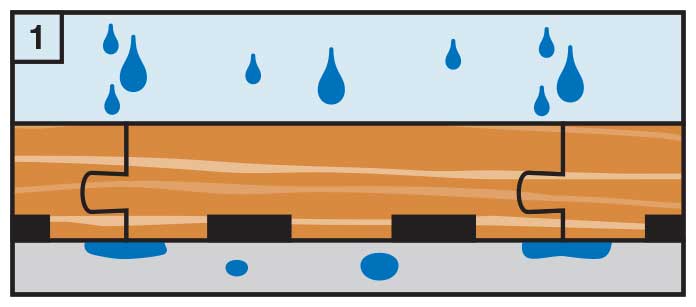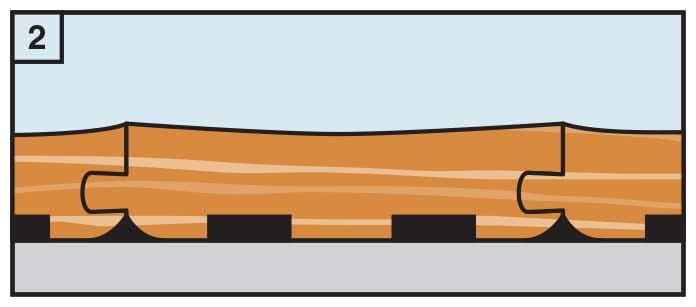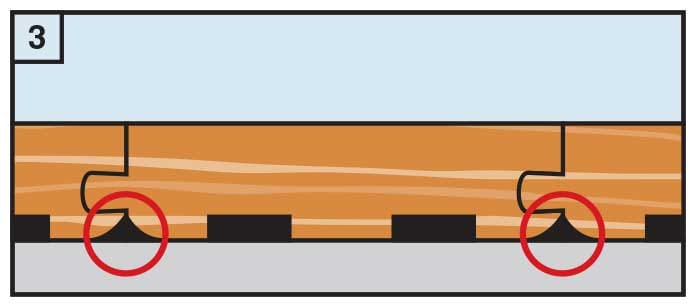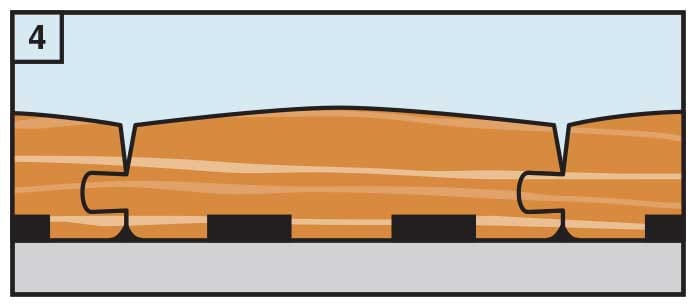Defining the Problem
Because wood is a natural product, with varying degrees of porousness – depending upon the species and finish – it expands and contracts with the presence of humidity. A reputable contractor will allow for such movement when installing a wood floor, but occasionally an excess of humidity, or even a flood, will cause problems that need to be addressed. Below are the most common issues we at Schenck & Company encounter in southeast Texas.
CUPPING & CROWNING
In a highly humid climate like Houston’s, most commonly in an environment where the temperature has not been controlled for long periods of time, it is not unusual to find a floor where the edge of each board appears higher than the center. Essentially, moisture – whether from humidity, a leak or a spill – has become trapped between the floor and the subfloor. As the moistened wood expands, compression results and the boards are crushed together and pushed upwards. If a cupped floor is sanded before the bottom dries completely, crowning will eventually occur (when the floor dries completely).
Wood is hygroscopic, constantly expanding and contracting with changes in moisture content. It is highly unlikely, therefore, that any floor will remain perfectly flat. Severe cases may be corrected by first identifying and eliminating the source of the moisture and second, by enabling the floor to dry completely, often with the aid of fans and dehumidifiers or with floor-drying mats. Only when moisture meter readings indicate that a floor is thoroughly dry should the floor be sanded and refinished.

1. Moisture from a spill or from excessive humidity enters the wood floor from above, seeping through the wood and settling between the wood and the subfloor.

2. As the top of the wood dries out – more rapidly than the bottom, where the water is trapped – cupping occurs. The edges of the wood are actually pushed up by the wood’s expansion.

3. If the cupped wood is sanded, the floor will initially appear flat. Yet moisture remains trapped between the floor and the subfloor and the bottom of the wood, remaining damp, is still cupped.

4. When the bottom of the wood eventually dries, it flattens out, leaving the top of the wood crowned.
BUCKLED FLOORING
Water causes wood to expand across the grain. When expansion is limited, it can cause wood floors to buckle – rise and pull away from the subfloor – to relieve the expansion pressure. Unlike a cupped or crowned floor, a buckled floor will never return to its original position without intervention. If caught early, buckled floors may be saved. Repair will involve the removal of some flooring to allow for better air circulation and drying. Only after the floor has dried completely can spot repairs and replacements be made.
CRACKS BETWEEN BOARDS
Because wood is a naturally porous material, it can be expected to expand and contract with changes in humidity, often with the seasons. In the winter, when the air in a home tends to be drier, wood shrinks leaving hairline gaps between the boards. Some floors show gaps more than others. In fact, due to their widths, plank floors can shrink more than twice as much as narrower strip floors do. As long as the gaps close up during the summer, when moister air causes the wood to expand, some gaps are considered normal. In extreme cases, when gaps become abnormally large or unsightly, repair may be necessary.
FLOODED FLOORS
Flooded wood floors may be saved, but time is of the essence. It is imperative to remove the water and begin the drying process as soon as possible. Fans and a dehumidifier or floor-drying mats can help speed the process. Rough sanding a surface finished floor can also help, but only the surface should be sanded; deeper sanding could cause crowning later.
If the flooded floor has a subfloor of plywood over concrete, there’s a greater likelihood that the flooring and subfloor will need to be removed completely and the concrete allowed to dry thoroughly. Even if the floor is constructed over pier and beam, it is important that it is completely dry, which can only be determined by moisture readings at all levels, before repairs begin.
For more information about your particular water damage, please e-mail Chris Schenck.
